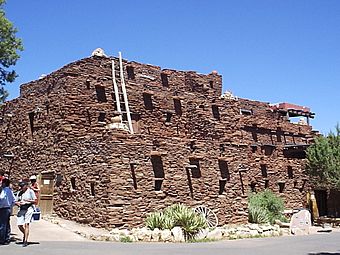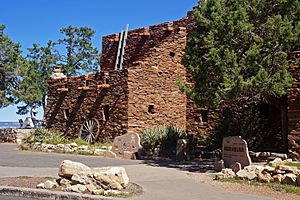Hopi House facts for kids
|
Hopi House
|
|
|
U.S. National Historic Landmark District
Contributing Property |
|
 |
|
| Location | Grand Canyon National Park, Arizona |
|---|---|
| Area | less than one acre |
| Built | 1904 |
| Architect | Mary Colter |
| Part of | Mary Jane Colter buildings (ID87001436) |
Quick facts for kids Significant dates |
|
| Added to NRHP | May 28, 1987 |
| Designated NHLDCP | May 28, 1987 |
Hopi House is a special building located at the Grand Canyon in Arizona. It sits on the South Rim of Grand Canyon National Park. This unique building was finished in 1904.
It was the very first of eight projects designed by a famous architect named Mary Colter at the Grand Canyon. Other buildings she designed include Bright Angel Lodge and Desert View Watchtower. The Fred Harvey Company built Hopi House. They wanted a place where Native American artists could create and sell their crafts.
The Hopi people, who have lived in this area for a long time, were chosen as the main artists. The building was made to look just like a traditional Hopi pueblo home. Hopi House first opened its doors on January 1, 1905. This was just before the famous El Tovar Hotel opened nearby.
Building Design: Hopi House
Mary Colter was a talented architect and interior designer for the Fred Harvey Company. She had great success with a similar project in New Mexico. Colter imagined Hopi House as a "living museum." Here, Hopi people could live and work, making and selling their traditional crafts.
The design of Hopi House was inspired by real Hopi homes in Oraibi, Arizona. When it was built, this accurate design was new to many visitors. It helped them learn about the architecture and lives of Native peoples in the Southwest. Inside, the building has different areas for showing art, selling items, and demonstrations.
Inside Hopi House: A Closer Look
Hopi House is built with sandstone blocks of different sizes. It has a stepped shape, like many traditional Hopi homes. The flat roof areas can be used as terraces, just like in real pueblos. The windows and doorways are small.
Inside, the walls are covered with adobe plaster. The ceilings are made from small tree branches, twigs, and grass, all covered with mud. Fireplaces are tucked into the corners of the rooms. An old staircase to the second floor has murals painted by a Hopi artist.
The second floor has a special room called a kiva, which holds Hopi religious items. The floors on this level were made to look like adobe but were actually cement. Later, in the 1930s, wood floors were added. The third floor used to be an apartment for the building's managers. Now it is used for storage, but some original features are still there. Many of the original furnishings chosen by Mary Colter on the main level are still preserved today.
Hopi House: A Historic Landmark
Hopi House is part of a larger group of important buildings. These are known as the Mary Jane Colter Buildings National Historic Landmark. It became part of this special group on May 28, 1987.
Hopi House and another building called Lookout Studio are also key parts of the Grand Canyon Village National Historic Landmark District. This means they are very important historical sites.




